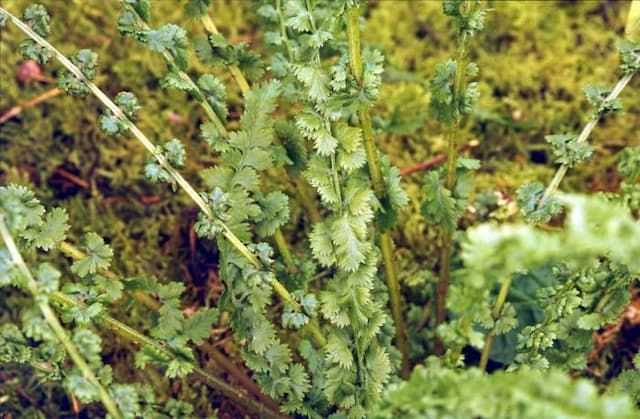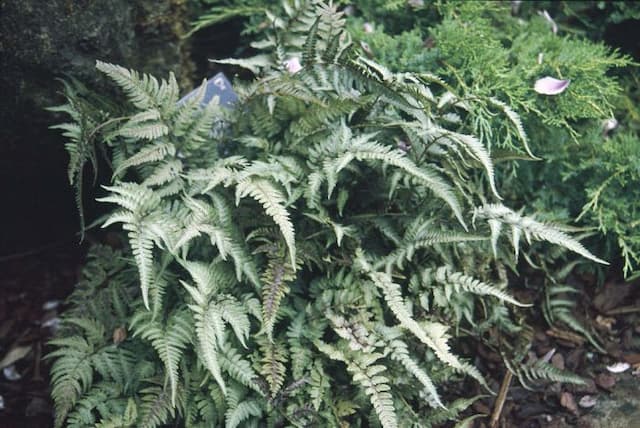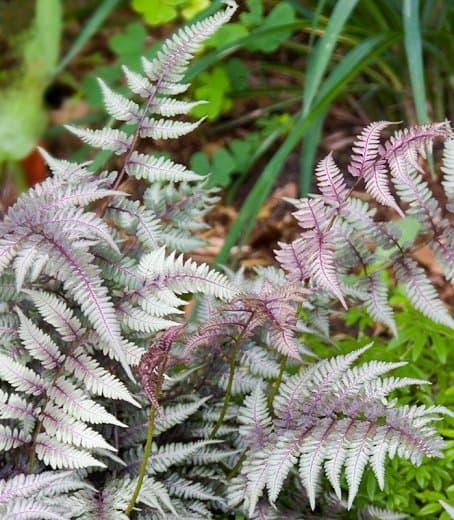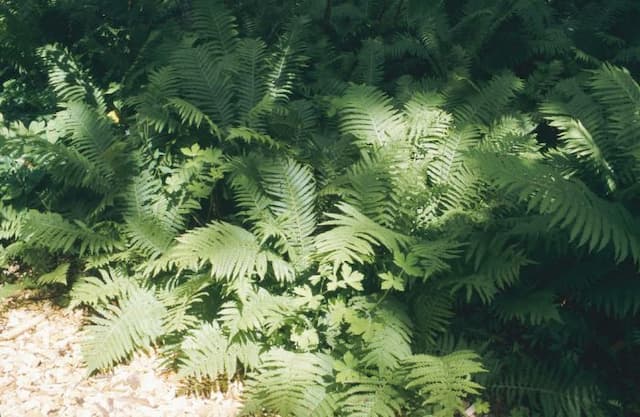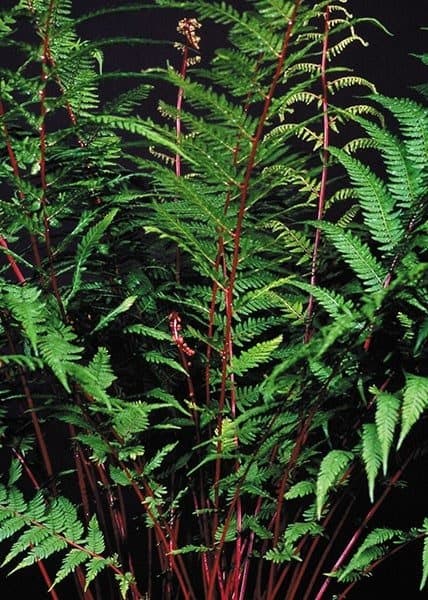Lady Fern Athyrium filix-femina 'Lady-in-lace'

ABOUT
The 'Lady-in-lace' is a type of fern known for its graceful, lace-like foliage. It has a delicate appearance, with finely divided fronds that give it a soft, feathery texture. The fronds are typically a lush green color and have an elegant, arching form that contributes to the plant's overall charm. Each frond is composed of numerous small leaflets that have a subtle, intricate structure, reminiscent of the finest lacework. These leaflets are arranged in a symmetrical fashion along the central stem of the frond, creating a visual rhythm that is pleasing to the eye. The fern's fronds emerge from a central crown that is generally not visible, as it is nestled close to the ground. As the fronds unfurl from curled-up beginnings, known as fiddleheads, they reveal their full splendor with a graceful unfolding. The 'Lady-in-lace' displays a natural elegance and is often admired for its ability to bring fine-textured visual interest to shaded garden areas or naturalistic settings where its distinctive form can be appreciated. Its appearance evokes a sense of delicacy and a connection to the woodlands and forested areas where ferns are commonly found.
About this plant
 Names
NamesFamily
Athyriaceae
Synonyms
Lady Fern, Lady-in-red, Female Fern, Lady-in-lace Fern
Common names
Asplenium filix-femina, Athyrium angustum, Athyrium asplenioides, Athyrium filix-femina var. michauxii.
 Toxicity
ToxicityTo humans
The Lady Fern (Athyrium filix-femina 'Lady-in-lace') is generally considered non-toxic to humans. There is no widespread evidence to suggest that touching or ingesting the Lady Fern typically results in poisoning or adverse health effects. Thus, it is generally regarded as safe to have around homes and gardens from a toxicity standpoint. However, it is always advisable to avoid ingesting any plant material unless it is known to be safe for consumption, and to keep in mind that individual allergic reactions can occur with any plant.
To pets
The Lady Fern (Athyrium filix-femina 'Lady-in-lace') is commonly recognized as non-toxic to pets such as dogs and cats. There are no well-documented cases of poisoning in pets from consuming this type of fern. It is often considered a safe plant to have in a home with pets. However, as with any plant, it is generally recommended to prevent pets from ingesting plant material to avoid any potential for an unusual reaction or gastrointestinal upset.
 Characteristics
CharacteristicsLife cycle
Perennials
Foliage type
Deciduous
Color of leaves
Green
Height
1-3 feet (0.3-0.9 meters)
Spread
1-2 feet (0.3-0.6 meters)
Plant type
Fern
Hardiness zones
3-8
Native area
Northern Hemisphere
Benefits
 General Benefits
General Benefits- Enhances Garden Aesthetics: The delicate and intricate lace-like foliage adds beauty and a sense of elegance to garden spaces.
- Low Maintenance: Lady Fern requires minimal care once established, making it a convenient choice for gardeners of all levels.
- Drought Resistance: Once established, it can tolerate periods of dryness, though it prefers moist environments.
- Wildlife Habitat: Provides shelter and food for wildlife, including caterpillars of some butterfly and moth species.
- Soil Erosion Control: Its root system helps to stabilize soil and prevent erosion, especially in shaded or woodland areas.
- Provides Texture: The fronds' unique texture makes it an excellent contrast or complement to plants with simpler leaf shapes.
- Cold Hardy: It can survive in cooler climates, making it a robust choice for northern gardens.
- Non-Invasive: Unlike some fern species, Lady Fern typically doesn't spread aggressively, reducing the risk of it overpowering other plants.
 Medical Properties
Medical PropertiesThis plant is not used for medical purposes.
 Air-purifying Qualities
Air-purifying QualitiesThis plant is not specifically known for air purifying qualities.
 Other Uses
Other Uses- Photographic Subjects: Garden photographers often use Lady Fern as a delicate and intricate subject for macro photography, capturing the detailed fronds and their patterns.
- Floral Arrangements: The Lady Fern can be used in fresh or dried flower arrangements, providing a feathery contrast to other blooms.
- Erosion Control: The plant can be used in landscaping to help control erosion, as its root system helps to stabilize soil on slopes or banks.
- Fauna Habitat: Lady Fern can create a niche habitat for certain insects and small animals, providing shelter and a microclimate within garden settings.
- Landscape Design: The fern can be used as a textural element in shade gardens, forming a soft backdrop for flowering perennials and bulbs.
- Educational Resource: Botany students may use Lady Fern to study the reproductive cycle of ferns, which is significantly different from flowering plants.
- Seasonal Displays: Due to its deciduous nature, Lady Fern can be used to add seasonal interest, with fronds changing color and dying back in the fall.
- Art Inspiration: Artists may use the intricate pattern of Lady Fern fronds as inspiration for designs, motifs, or patterns in their work.
- Craft Material: The dried fronds of the Lady Fern can be used in craft projects, like making bookmarks or adding to homemade paper for texture and visual interest.
- Theater and Film: Set designers may incorporate Lady Fern into naturalistic sets for theater, television, or film to create an authentic woodland scene.
Interesting Facts
 Feng Shui
Feng ShuiThe Lady Fern is not used in Feng Shui practice.
 Zodiac Sign Compitability
Zodiac Sign CompitabilityThe Lady Fern is not used in astrology practice.
 Plant Symbolism
Plant Symbolism- Femininity: The common name 'Lady fern' reflects the delicate and elegant nature of this plant, symbolizing the grace and refinement traditionally associated with femininity.
- Discretion: The fine, lacy leaves might be associated with the notion of discretion, suggesting a sense of fine manners and subtlety.
- Solitude: Lady fern often thrives in shady, quiet woods, symbolizing a love for peaceful solitude and tranquil spaces.
- Protection: Ferns in general are often seen as protective plants with their ability to create an understory haven in forests; thus, Lady fern could represent a shield from negativity.
- Eternal Youth: With its lush, perennial greenery, Lady fern symbolizes the quest for eternal youth and the enduring spirit of nature.
- New Beginnings: As ferns unfurl their new fronds in a pattern known as a fiddlehead, they represent new beginnings and the unfolding of new opportunities.
- Secret Bond: In the Victorian language of flowers, ferns symbolized secret bonds of love, so Lady fern could carry this secretive, hidden meaning within its fronds.
 Water
WaterFor the Lady Fern (Athyrium filix-femina), maintain consistent moisture by watering deeply once a week. During periods of drought or extreme heat, increase watering to twice a week to ensure the soil remains evenly moist, but not waterlogged. Typically, Lady Ferns in garden settings require about 1 gallon of water per week, depending on soil type and climate. Reduce watering in the winter when the plant is not actively growing. It’s important to avoid letting the soil dry out completely, which can stress the plant and cause foliage to brown.
 Light
LightLady Ferns thrive in dappled sunlight to full shade, making them excellent for a shaded garden area where few other plants can grow. They should be placed under the canopy of open trees or in a spot where they can receive filtered light. Direct, harsh sunlight should be avoided, as it can scorch their delicate fronds and lead to stress and poor growth.
 Temperature
TemperatureThe Lady Fern prefers cooler conditions and can typically tolerate temperatures down to 20 degrees Fahrenheit, making it a hardy addition to many gardens. The ideal temperature range for vigorous growth is between 55 to 75 degrees Fahrenheit. Extreme heat above 95 degrees Fahrenheit can damage the fern, particularly if coupled with dry soil conditions.
 Pruning
PruningPruning Lady Ferns is typically done to remove dead or damaged fronds and to maintain a tidy appearance. It's best to prune in early spring before new growth begins. Pruning can be done annually, as needed, to remove any old fronds that have withered over winter. This helps encourage healthy new growth and improves air circulation around the plant.
 Cleaning
CleaningAs needed
 Soil
SoilLady fern requires a soil mix that is rich in organic matter with good drainage. The best soil mix for the Lady fern is a blend of loamy garden soil, peat moss, and perlite or coarse sand, in equal parts. This fern prefers an acidic to neutral pH range of 4.0 to 7.0. Amend with compost annually to maintain soil fertility.
 Repotting
RepottingLady fern should be repotted every 2 to 3 years to refresh the soil and accommodate its growth. It's best to repot in the spring just before new growth begins. If the fern has become too large or the center of the plant has died out, it can be divided during repotting.
 Humidity & Misting
Humidity & MistingLady fern thrives in high humidity conditions, ideally between 60% to 80%. To maintain these levels, especially indoors where air can be dry, using a humidifier or placing the pot on a tray of wet pebbles can help increase the ambient moisture around the plant.
 Suitable locations
Suitable locationsIndoor
Place Lady fern in bright, indirect light, and maintain high humidity.
Outdoor
Plant Lady fern in partial to full shade, with moist soil.
Hardiness zone
3-8 USDA
 Life cycle
Life cycleThe Athyrium filix-femina, commonly known as the Lady Fern, begins its life cycle when spores, typically found on the undersides of the fronds, are released into the environment. These spores germinate under moist conditions, forming a heart-shaped gametophyte, which is the sexual phase of the plant. The gametophyte produces both sperm and eggs, which, when combined through water-assisted fertilization, develop into a new sporophyte — the fern itself. The young sporophyte, initially a small fern, gradually matures and unfurls its characteristic feathery, lace-like fronds. As a perennial plant, the Lady Fern will enter a period of dormancy during the winter, with the fronds dying back, to re-emerge the following spring from the rhizomes. Throughout its lifetime, which can span multiple years, the plant will continuously cycle through periods of growth and dormancy, releasing new spores each season to propagate the next generation.
 Propogation
PropogationPropogation time
Spring-early summer
Athyrium filix-femina 'Lady-in-Lace', commonly known as Lady Fern, is typically propagated by division. The most popular method of propagation for this plant is through division of its rhizomes. This is best done in early spring before the fronds begin to unfurl. To propagate by division, carefully dig up the plant and use a sharp, clean knife to cut the rhizome into sections, ensuring each section has at least one growing point or "eye." Replant the divisions at the same depth as the original plant, spacing them about 12 to 24 inches (approximately 30 to 60 centimeters) apart to allow room for growth. Water the new divisions thoroughly to help establish them. This asexual method of propagation ensures that the new plants maintain the characteristics of the parent cultivar.
